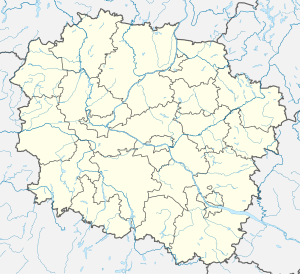Toruń Railway Bridge
Coordinates: 53 ° 0 ′ 35 ″ N , 18 ° 37 ′ 17 ″ E
| Toruń Railway Bridge | ||
|---|---|---|
| Official name | Ernest Malinowski railway bridge | |
| Crossing of | Vistula | |
| place | Toruń | |
| construction | Truss bridge | |
| overall length | 972 m | |
| Number of openings | 5 stream openings | |
| Clear width | 94.16 m | |
| Pillar strength | 6.28 m | |
| start of building | 1870 / | |
| completion | 1873/1948 | |
| location | ||
|
|
||
The Toruń Railway Bridge , officially the Ernest Malinowski Railway Bridge , is the only railway bridge over the Vistula in the city of Toruń . It stands between the train stations Toruń Główny (Toruń Central Station) on the left, southern side of the Vistula and Toruń Miasto (Toruń City) on the right side on the eastern edge of the old town.
It leads the route No. 353 of the Polish State Railways (PKP) from Poznań (Poznan) over the Vistula, which continues to Chernyachovsk (Insterburg) in the Russian Oblast Kaliningrad ( Railway Poznań – Toruń and Railway Toruń – Chernyachovsk ).
The bridge has been named after Ernest Malinowski since 1999 , a Polish civil engineer who emigrated to Paris and trained there at the École nationale des ponts et chaussées , who planned and built the Ferrocarril Central Andino in Peru .
Railway bridge near Thorn (1873)
description
The Thorn railway bridge was the second railway bridge over the Vistula after the Dirschau bridge, which was completed in 1857 . Like the Dirschauer Bridge, the bridge in Thorn, built between 1870 and 1873, was a combined road and rail bridge. It was supposed to connect the Posen-Thorner Railway and the Bromberg-Warsaw branch of the Prussian Eastern Railway with the Thorn-Insterburger Railway . At the same time, it was supposed to relieve the wooden Pfahljoch bridge , which was built in 1500 as an extension of what would later become Ulica Mostowa (bridge road) and has since been painstakingly preserved or rebuilt against floods and the annual ice drift .
The wrought-iron bridge, designed by Johann Wilhelm Schwedler , was 972 m long. Its five stream openings were framed by two bridge portals designed by the architect Heinrich Strack . A foreland bridge over the flood bed of the Vistula followed the river bridge on the southern side , which led in a long curve with 11 fields to today's Toruń Główny train station . On the other side, the river bridge was connected to the high-altitude railway embankment with a short field. The lower edge of the iron structure was 2 m above the flood of 1570, the highest recorded water level.
The 12.4 m wide river bridge was divided into a 4.24 m wide area for the track , which was separated by a grid (0.16 m) from the 6.28 m wide lane for the carriages and wagons. The bridge girders were each 0.86 m thick.
The river bridge was 495.88 m long between its portals, divided into 5 fields with a clear width of 94.16 m (300 Prussian feet ) and 4 pillars 6.28 m (20 feet) thick at its head . The two portals were each 6.21 m long. The iron superstructure of these openings consisted of two Schwedler girders with a span of 97.29 m from center to center of the supports.
The openings of the approach bridge had clear widths of 44.48 + 10 × 34.52 m and 3.77 m thick piers. The short field on the right bank of the Vistula also had a clear width of 34.52 m. The superstructure consisted of conventional, parallel-belt trussed girders.
Another story
The old wooden bridge burned down in 1877 and was never rebuilt. Toruń only had one bridge over the Vistula until 1934 when the Józef-Piłsudski Bridge was opened to traffic on the other side of the old town. The bridge from 1873 was then closed to road traffic and provided with a second track.
In 1939, both bridges were blown up by the Polish army after the German invasion of Poland . The railway bridge was then rebuilt, but in 1945 the Wehrmacht was blown up again while retreating from the Red Army .
Ernest Malinowski Railway Bridge (1948)
After the war, the ruins of the superstructures were cleared away and the towers of the Prussian bridge portals were removed down to the bottom floor. The bridge's pillars were still intact and could be used to rebuild the bridge.
The bridge, completed in 1948, therefore also consists of a 495.88 m long river bridge with 5 spans with clear widths of 94.61 m each. In view of the enormous increase in the weight of locomotives and trains in the previous eight decades, two parallel, structurally independent steel lattice structures with a curved upper flange were built for one track each. A pedestrian walkway is mounted on the outside, but it is closed to public traffic. On the approach bridge, an independent supporting structure made of solid wall girders was also created for each track.
Web links
- Railway bridge over the Vistula near Thorn. In: Zeitschrift für Bauwesen , year 26, 1876, column 35–54 and column 197–218 as well as pages 14–20, plan drawings in the atlas for the journal for construction , year 26, 1876
Individual evidence
- ^ NN: Railway bridge over the Vistula near Thorn, column 217
- ↑ a b c d NN, column 35
- ↑ File: 1870mostdrewT.jpg : Historical photo
- ↑ a b NN, column 218
- ^ NN, column 35 with correction in column 197
- ↑ a b c d NN, column 197
- ↑ 1 Prussian foot = 0.31385 m
- ↑ The draft plans were written in feet.
- ^ Atlas, sheet 17: ground plan




